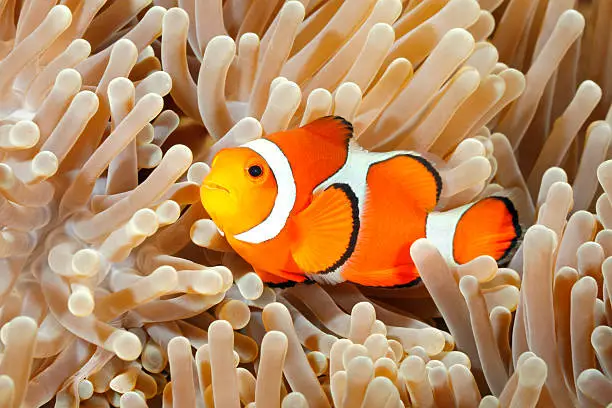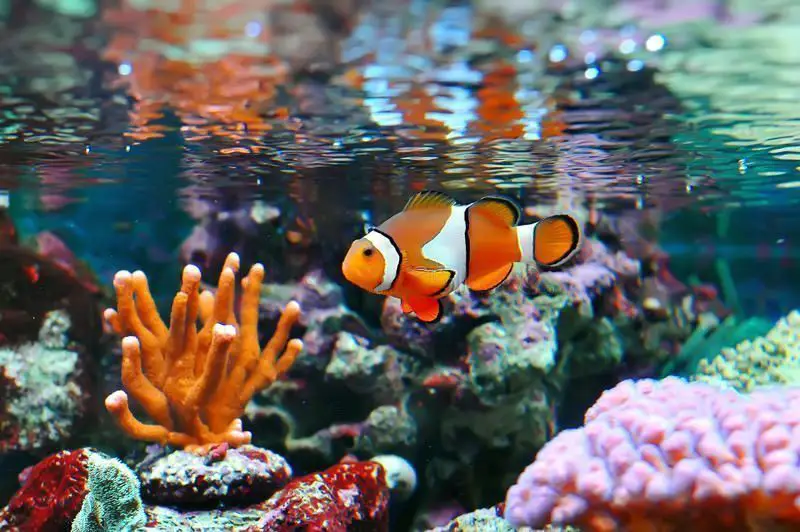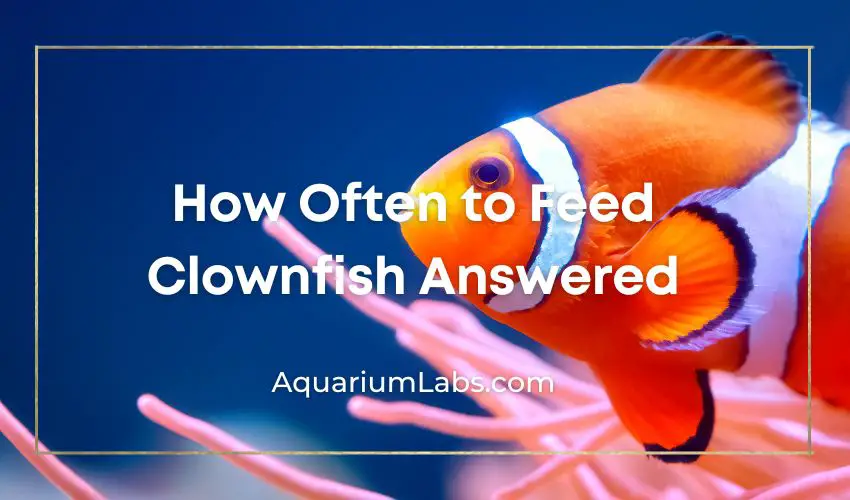Introduction
Your clownfish’s overall health and growth depend on knowing how much food to give it and adopting a good feeding plan.
It’s critical to know the answers to questions about their feeding regimen to ensure that your clownfish is healthy.
In this article, we’ll be addressing essential questions on:
- How regularly should you feed clownfish;
- what amounts of food is enough for your clownfish to eat;
- What they consume;
- How should you provide them;
- and lots more.
Let’s dive right in!
How Often Should You Feed Clownfish?
The key issue here is this. Giving your clownfish the ideal balance of plant and animal materials is fine and dandy. But then, how often should you give them food? This is important since regularity will have an impact on supply.
Typically, your clownfish will become harmed if you overfeed them. On the other hand, if you do not give them sufficient food, you may underfeed them and incur health problems.

The solution is both simple and challenging. We’d advise you to treat your clownfish two times per day. You will likely hear this estimate from most fish specialists you consult.
But, this is especially the case for adult clownfish who’ve already grown to their maximum size. Since they’re still developing, fingerlings have more robust appetites and tend to consume more than their older siblings. To boost the appetite of a breeding clownfish, you’d have to provide them with the same amount of nutrition as you would for fingerlings.
Feeding young clownfish three to four times will yield the ideal outcomes. You can also feed reproducing fish similarly. And, don’t forget that moderation is key to a healthy clownfish.
What Do Clownfish Feed On?
One exciting thing about clownfish is that they are omnivorous creatures. They’ve got a healthy preference for both plant and animal matter.
A part of clownfish’s diet comprises algae, but most of their food is tiny zooplankton from the surrounding water, like tunicate larvae and copepods.
When in the wild, clownfish eat anything, including larvae, fish eggs, and algae, but not when they are in saltwater aquariums or tanks.
Additionally, they’ve been observed eating crustaceans, brine shrimp, and anemone tentacles in the wild.
They eat food particles from anemones in their native habitat. The sea anemone receives nutrition from their feces as well.
Make sure that their diet doesn’t get boring. Try to mix things up a bit to make it tasty. While they prefer fresh foods, you can occasionally mix frozen food and dried frozen food, pellets, flakes, and flakes in their treats.

They eat vegetables like spinach and Nori. Although they are omnivorous fish that consume both animal and plant matter, you must not let your clownfish survive by feeding on either plant or animal matter but both. Like humans, changing your clownfish’s nutrition can keep things exciting for them.
While at it, ensure that the water in your tank or aquarium is not contaminated. If you suspect contamination somewhere, replace it with cleaner water.
Do Clownfish Eat a Lot?
Clownfish are famous among fish keepers since they’re not fussy consumers. They eat nearly everything you put in their aquarium for them to eat.
Sadly, if you continue putting clownfish food into the fish tank, they’ll continue eating it without stopping. They exhibit little to zero self-restraint in this regard. You must avoid giving them extra food that would be detrimental to their health.
It is not enough to choose how frequently you’ll treat your clownfish. The time between meals is equally significant.
You still face the danger of overfeeding them even if you only feed them once per day by putting excessive amounts of food inside their aquarium and hoping it will sustain them all day.
Don’t feed your clownfish more than they can consume in 2 to 3 minutes. You can reduce that time to around one minute based on how often you serve them. If you treat them once daily, you can increase it to 5 minutes.
Ensure they finish every last bit of food you give them within the allotted time. You might have fed them excessively if they cannot complete the food.
For example, if you decide to give them some food for three minutes, keep increasing the quantity until you provide them with just the amount of food they can finish within that three minutes.
You’re still feeding them a lot if some food remains after that time. Food in overabundance is not beneficial. Also, this will mess with their water and constitute an unhealthy experience for you and your clownfish.
How Much Time Can Clownfish Go Without Eating?

You should never feed an adult clownfish upwards of four times each day.
Clownfish, as was previously indicated, provide some unique challenges. Firstly, even though you are supposed to feed them once or twice daily, clownfish can go for days without food.
Speak to some knowledgeable fish keepers on how to feed clownfish. Many of these folks will admit that feeding clownfish can be somewhat tricky.
Some will even tell you for free that their beloved clownfish haven’t eaten in 2 or 3 days. You may even be lucky to see people who claim that their fish have managed to go a whole week without eating.
Any fish’s ability to go without food for an extended time relies on its feeding patterns and size. Often, older, larger fish may go longer without eating.
This can be attributed to their significantly larger fat stores. Younger, smaller fish don’t have as much luck. Older clownfish will decline food more quickly than the younger ones.
Seldom does anyone purposefully deprive their clownfish of the required nutrition. They sometimes have to do that since they must leave their house for longer times and can’t afford to purchase an automated feeder or employ a fish caregiver.
As a result, they are entirely reliant on their clownfish’s capacity to go without nourishment for several days.
In general, carnivorous fish can go more without eating than herbivorous fish. We can attribute this to the nonavailability of meat in their natural environment.
They have developed to endure times of the year when they can’t get food. Herbivores aren’t so fortunate. They have been used for daily meals. Therefore, combining both characteristics, omnivores such as clownfish can be classified as being in the center.
There are certain things to watch out for, even though it could be challenging to determine whether your clownfish are famished. Starvation may be the problem if they keep attempting to escape from their tanks.
Preparing for a Limited Supply
You should prepare your clownfish if you want to go for several days without providing them with some food. Some clownfish may not thrive right away.
Take advantage of this prep phase opportunity to assess the situation once you depart. You might consider it as a hint that your clownfish will endure your departure if they manage to survive and live in such conditions.
You can attempt to get them off their new feeding regiment fast if their health drops.
Some individuals do this by gradually reducing how frequently they treat their clownfish. Some claim that lowering the temperature of the water will cause them to burn through their meal more slowly.
You may also alter the length of the tank’s day by adjusting its artificial illumination. Their movements will be constrained, which may lessen their desire for food.
Hire a fish caregiver who can fill the tank with food every one or two days while you’re away if the above methods don’t yield the outcomes you’re looking for. Alternatively, you can get an automatic fish feeder.
Can Clownfish Be Overfed?
Treating your fish no more than four times per day makes sense. You can, however, make exceptions. For example, it’s been suggested that clownfish can consume Cyclop-eeze and other genetically modified organisms six times each day.
That seems absurd, of course. Nevertheless, you should consider the food type. You may treat your clownfish with certain food products by combining their powdered form with water and pouring them into your tank with the aid of a turkey baster. It contains tiny crustaceans.
Additionally, if you complement their feeds with other forms of fish meal, you may likely have to introduce different sea life such as crustaceans into your tank two or even four times daily.
The fishmeal market is constantly changing. Some companies provide foods that are so intricate that you’ll have to alter your clownfish dietary plan. However, if you’ve decided to stick with conventional food products, limit your feedings to 1 or 2 daily.
Where do Clownfish Eat?
Clownfish that are younger and smaller do not always explore their tank. They like remaining in designated safety areas. Treat them close to these particular spots if you’d like them to feed till they are satisfied.
But, mature clownfish are unique. Since clownfish originate from a tribe of carnivores, they’ve developed a predatory disposition.
Disperse their food on the tank’s surface when you feed them. Let the water’s currents carry it. Your clownfish will start moving unerringly towards the direction of the food source upon sighting it.
Although it is not a great idea to halt the water’s currents, you should ensure that the movement is at least gentle. Or else, feeding your clownfish could become a challenging task.
What Foods Do Clownfish Feed on Naturally?
Small crustaceans, a bunch of algae, and some leftover fish from anemones make up the vast majority of a clownfish’s diet in their natural environment.
They do not feed at regular intervals, as you may have already guessed. They occasionally consume more fish food than they would digest. Like most other fish species, clownfish are opportunistic feeders.
Clownfish Alternative Food Sources
Because they are omnivores, clownfish have access to alternative fish food sources, which allows them to survive for days even without the meals you give them.
If you pay close attention, you may even see them devour algae or nibble at the rocks, ornaments, and walls.
Also, clownfish may consume parasites and leftover food from an anemone. Anemones are water organisms that feed on other aquatic creatures while having a plant-like appearance. Clownfish will usually eat anything the anemones don’t finish.
For more clownfish marine food sources, check out our list here.
Conclusion
Clownfish have some of the most exciting eating regimens. Juvenile clownfish consume food more often than adults, who you should serve 3-4 times daily. This feeding schedule allows them to grow to their maximum size. While adult clownfish should be fed at least twice per day.
It’s not a good idea, as it can potentially malnourish your clownfish, but they can go up to a week without eating. How much time depends on the plants inside your tank, particularly the anemones, and your preparation phase before departing. In our opinion, it’s best to buy an automatic fish feeder just in case.
Generally, testing to see what works is the ideal approach to figure out your clownfish dietary preference. You’ll eventually discover the needs of your clownfish upon completing consistent observation.


